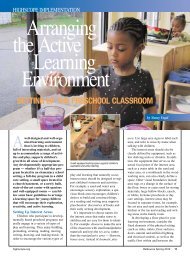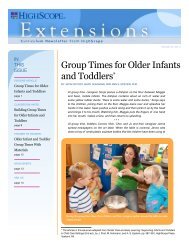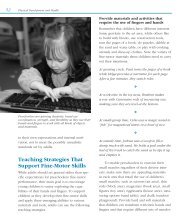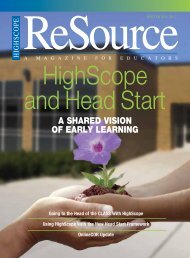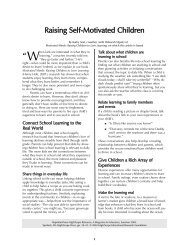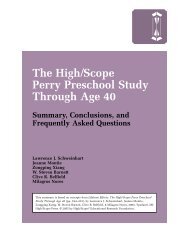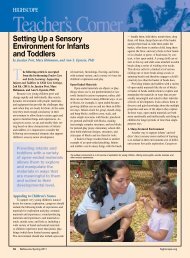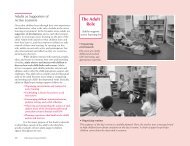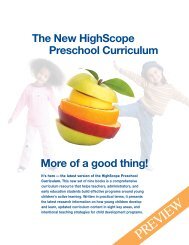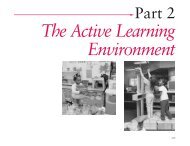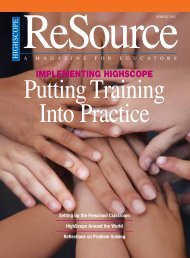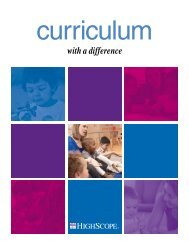DIVERSE AND INCLUSIVE CLASSROOM - High/Scope Educational ...
DIVERSE AND INCLUSIVE CLASSROOM - High/Scope Educational ...
DIVERSE AND INCLUSIVE CLASSROOM - High/Scope Educational ...
You also want an ePaper? Increase the reach of your titles
YUMPU automatically turns print PDFs into web optimized ePapers that Google loves.
HIgHLY EffECTIvE PROgRAmS<br />
carry out, and reflect on (Hohmann, Weikart,<br />
Epstein, 2009). The Abecedarian program presented<br />
the Learninggames child development<br />
activities (Sparling & Lewis, 1981) to children<br />
up to age three and used several standard preschool<br />
curricula focusing on communication<br />
skills after age three. The Child-Parent Centers<br />
used a literacy curriculum and a specific learning<br />
model in other subject areas. The Centers<br />
focused on a variety of activities, including<br />
individualized and interactive learning, smallgroup<br />
activities, and frequent teacher feedback.<br />
Teachers. Perry Preschool and Child-Parent<br />
Centers teachers were state-certified teachers,<br />
while Abecedarian teaching staff had a range<br />
of educational backgrounds. Perry Preschool<br />
teachers were state-certified in elementary and<br />
special education. Child-Parent Centers were<br />
staffed by early childhood-certified teachers<br />
and aides. Abecedarian project teaching staff<br />
had professional backgrounds ranging from<br />
paraprofessional to graduate degrees in early<br />
childhood education, all with extensive experience<br />
working with young children.<br />
Outreach to Parents. Perry and Chicago<br />
engaged in extensive outreach to parents, and<br />
Abecedarian engaged parents in child care. The<br />
Qualified and well-trained teachers who have<br />
extensive experience working with children are<br />
essential to a program's effectiveness.<br />
Perry program involved parents as partners with<br />
teachers through weekly home visits to discuss<br />
their children’s developmental progress, and<br />
occasional group activities. The Chicago Child-<br />
Parent Centers required parent participation that<br />
involved volunteering in the program a half-day<br />
each week. The Abecedarian project required<br />
parents to support their children in full-day,<br />
full-year child care throughout early childhood.<br />
Scrutiny of the highly<br />
effective programs that<br />
have identified longterm<br />
effects and return<br />
on investment offers<br />
guidance on how early<br />
childhood programs<br />
can achieve these<br />
higher standards.<br />
Assessment. All three highly effective<br />
programs included extensive assessment of<br />
children’s development. While they did not<br />
engage in systematic data collection on pro-<br />
Introducing the New<br />
<strong>High</strong><strong>Scope</strong> Key Developmental<br />
Indicators (KDIs)<br />
by Ann S. Epstein, PhD<br />
<strong>High</strong><strong>Scope</strong> has always been a leader in early childhood<br />
education. In this tradition, we are excited to announce the<br />
latest update in the <strong>High</strong><strong>Scope</strong> Preschool Key Developmental<br />
Indicators (KDIs), the content component of our curriculum.<br />
The new KDIs are based on the latest information<br />
about child development and how adults can support early<br />
learning in all domains. They can be easily aligned with<br />
state standards and other program requirements.<br />
what’s the same? what’s new?<br />
<strong>High</strong><strong>Scope</strong>’s validated educational approach — active<br />
learning, adult-child interaction, the learning environment,<br />
the daily routine, child observation, and program planning<br />
— remains the same. The adult scaffolding strategies to<br />
support children’s learning are also valid, and teachers<br />
can continue to use them with confidence. The eight content<br />
areas for organizing the curriculum are unchanged as<br />
well, and reflect our continued commitment to comprehensive<br />
and meaningful learning. However, the new KDIs<br />
within each area will help adults broaden their child development<br />
focus and be more intentional in their teaching.<br />
There is much continuity with the former KDIs, but with<br />
enhanced attention to the content young children need to<br />
succeed in school and in life. Moreover, the new KDIs are<br />
more consistent with the in-depth materials <strong>High</strong><strong>Scope</strong><br />
has developed in specific content areas such as literacy,<br />
mathematics, science, social-emotional development,<br />
physical development, and the creative arts.<br />
The new <strong>High</strong><strong>Scope</strong> Preschool KDIs (opposite) fall<br />
into eight content areas: Approaches to Learning; Social<br />
and Emotional Development; Physical Development and<br />
Health; Language, Literacy, and Communication; Mathematics;<br />
Creative Arts; Science and Technology; and Social<br />
Studies. As always, <strong>High</strong><strong>Scope</strong> will continue to develop<br />
materials and offer training to support practitioners as<br />
they implement the curriculum’s teaching practices and<br />
educational content.<br />
For more information, visit our website:<br />
www.highscope.org<br />
Ann S. Epstein, PhD, is <strong>High</strong><strong>Scope</strong>’s Senior<br />
Director of Curriculum Development.<br />
6 ReSource Winter 2010–2011 highscope.org



